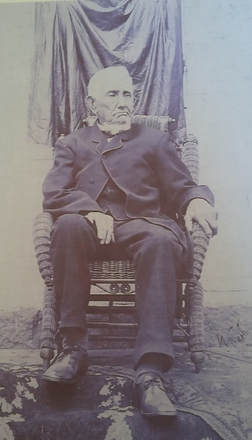 William Poor
William Poor Early on, the Poors were ardent abolitionists, so much so that in 1846 they left their place of worship and helped start another church in Andover, because they didn't want to pray alongside anyone who wasn't anti-slavery. As for William's or any other Poor's participation in the Underground Railroad, I found mentions only in secondary-source materials -- unsurprisingly, given the clandestine nature of the operation. To cite some of the most recent ones: a 2011 report published by the historian of the church abandoned by the Poors declares that the family "built wagons with false bottoms and ran a stop on the Underground Railway through Frye Village [former name of my neighborhood, now known as Shawsheen Village] for years.” A book titled Andover Stories, published in 2011 jointly by my local historical society and the Townsman, similarly states: “In false-bottomed wagons made in [the Poor family’s] shops, escaping slaves could safely be concealed for transport under a load of produce or hay.” Likewise, an early photograph in the historical society's collection showing the Poor compound of shops bears a present-day caption that claims William “built wagons with hidden compartments to help smuggle slaves to freedom.” And a circa 1895 photo of William himself, looking quite elderly just a few years before his death, was recently captioned by the society this way: "Poor started a successful wagon shop in 1883 [sic]. His shop was also used as an Underground Railroad stop. It is estimated that several hundred slaves stopped at his shop.” That glaringly wrong date, nearly two decades after the Civil War ended, gave me pause. What else did the historical society have wrong? That "several hundred" people had been sent on their way to freedom in Canada seemed a phenomenal, too phenomenal, number. I was, nonetheless, still hoping to be convinced that the Poors truly were my local heroes, and pressed on with my informal investigation.
In 1999, when Juliet Haines Mofford gave the historical society's Annual Memorial Lecture, her topic was "The Underground Railway: Andover & the Anti-Slavery Movement." When I saw the typed transcript at the historical society recently, I recalled that I had been a lecture attendee all those years ago. The transcript shows that Mrs. Mofford, a prodigious researcher and writer, merely suggested what others later repeated as fact.* The Poor wagons would have been "... handy for smuggling slaves...," she opined. It would have been "easy to hide them under a load of produce...," she speculated, and "easy for someone with William Poor's skills to build wagons with false bottoms..." As for her sources, among them was Wilbur H. Siebert's The Underground Railroad in Massachusetts, published by the American Antiquarian Society in 1936. Quoting the Ohio State University history professor, Mrs. Mofford said, "'When [William] Poor heard a gentle rap on his door or other subdued sounds in the night,' he dressed quickly, went out, harnessed his mare Nellie to a covered wagon and started with his dusky passengers, probably for North Salem, New Hampshire.'”
Professor Siebert named Joseph Poor as being among others in Andover who "could be counted on to speed the black wayfarers on their journey." Crediting the academic, Mrs. Mofford repeated his words. But Professor Siebert, born in 1866, could not have been a witness to what he described. So where did he get his information? A footnote acknowledges a letter written to him on November 25, 1934, by a Miss Marion La Mere; an undated letter written to her by a Reverend William C. [sic] Poor; and a book, History of Lawrence, Mass., published in 1924 by Maurice B. Dorgan. Via the Internet, I learned that, like Professor Siebert, neither of them could have been eyewitnesses. Miss La Mere, a lodger at an Andover address, was born circa 1889, Mr. Dorgan in 1880. So it would seem the reverend -- i.e., William George Poor (1858-1939), son of Joseph, grandson of William -- would have had the most reliable information. As it happened, the retired Congregationalist minister, a graduate of Dartmouth College and Yale Divinity School, spoke about his recollections of the Underground Railroad in Andover to a local woman's club and their guests on December 5, 1932, and the Townsman published an account of it.
According to the reporter, Reverend Poor, who was visiting from his home in Upton, Massachusetts, near Worcester, told the audience that two Underground Railroad stations had been located in the Poor Street vicinity, his old Andover neighborhood. One was the ink shop of William C. Donald & Company at the corner of Poor and Main Street. As for the other, he cagily offered, Elijah Hussey (1801-1869) would have had something to say about it, "only he didn’t talk about it.” I take that to mean it was located at Hussey’s sawmill or, if not there, then at Hussey's residence, a large Victorian structure that once stood on the very spot where my own house at 53 Poor Street, plus the Aberdeen condominium, at 354 North Main Street, stand today. That brings the story closer to home for sure, but no closer to the certifiable truth.
To be continued.
*There is even a repetition of this idea on a National Park Service's website that is devoted to the Underground Railroad in Essex County, Massachusetts (https://www.nps.gov/sama/learn/historyculture/upload/UGRRsm.pdf): "Frye Village was the location of Elijah Hussey’s sawmill, the ink factory of William C. Donald, and the flourishing wagon factory of William Poor and his sons, where wagons were built with false bottoms in order to secretly transport slaves." Credit is given to "Julie Moffitt [sic], Andover Historical Society."

 RSS Feed
RSS Feed
